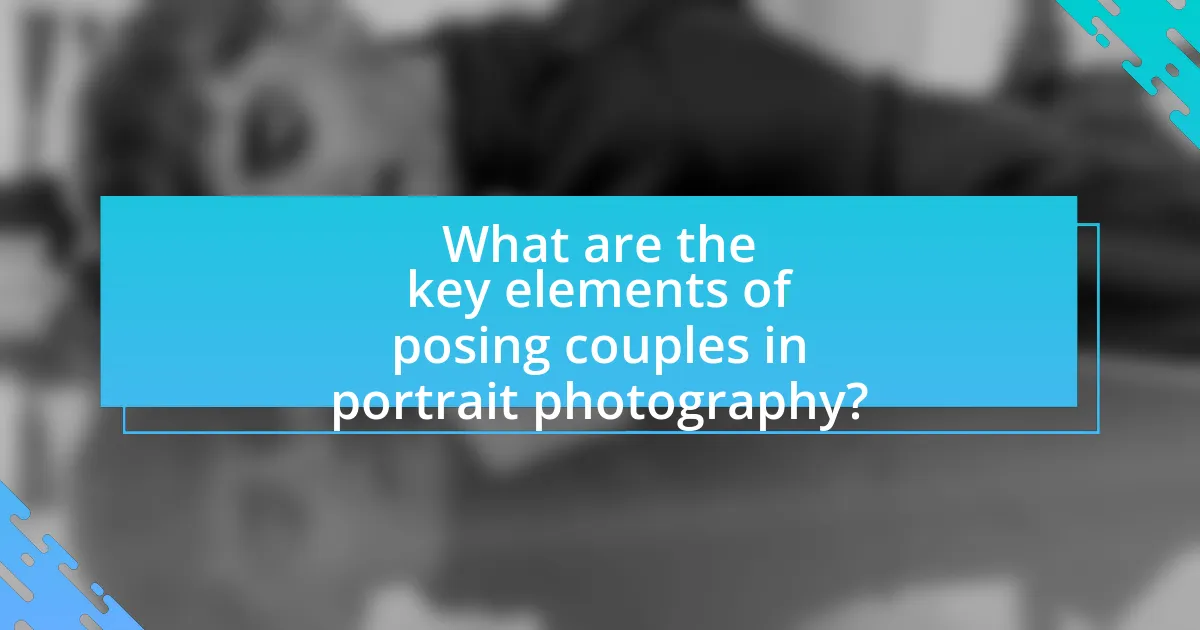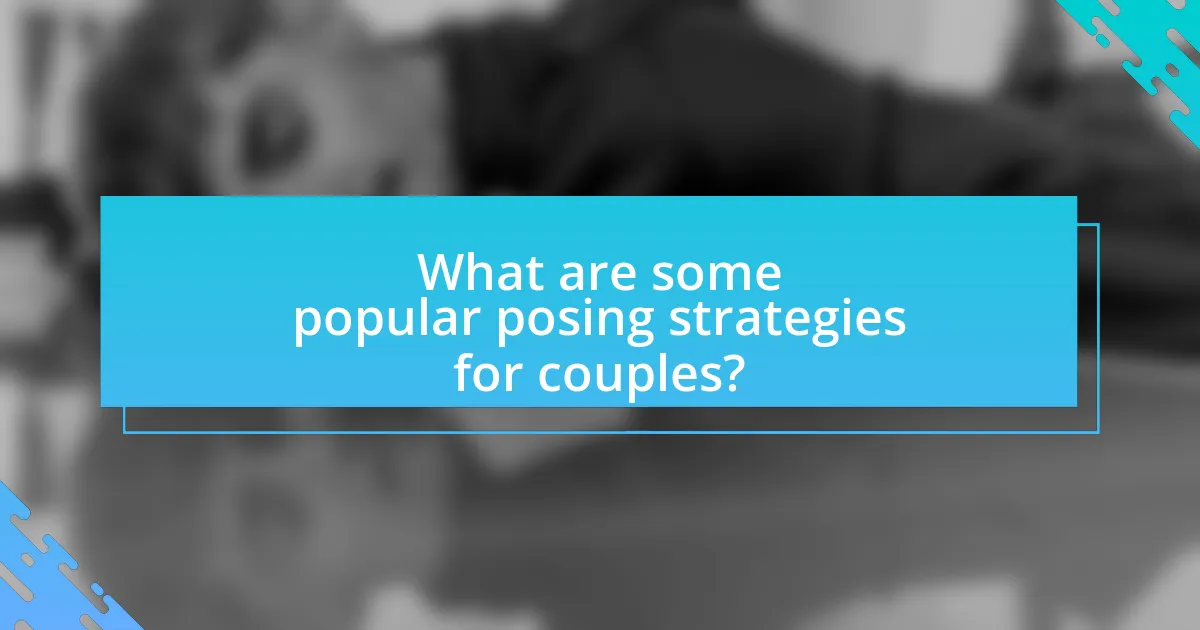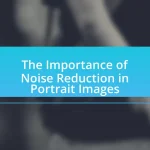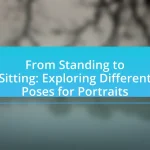The article “Dynamic Duos: Posing Strategies for Couples in Portrait Photography” focuses on essential techniques for effectively posing couples to enhance emotional connection and visual appeal in portrait photography. Key elements discussed include body alignment, interaction, and the influence of body language on poses. The article also explores compositional techniques, the importance of lighting, and the role of props and location in creating engaging images. Additionally, it provides practical tips for photographers to direct couples, minimize awkwardness, and capture authentic moments, ensuring that the resulting portraits reflect genuine emotions and the unique dynamics of the couple’s relationship.

What are the key elements of posing couples in portrait photography?
The key elements of posing couples in portrait photography include body alignment, interaction, and emotional connection. Body alignment involves positioning the couple in a way that highlights their relationship, such as angling their bodies towards each other to create intimacy. Interaction is crucial; couples should engage with one another through gestures like holding hands or leaning in, which enhances the natural dynamics of their relationship. Emotional connection is vital, as capturing genuine expressions and moments of affection leads to more compelling portraits. Research indicates that couples who are comfortable and connected in their poses yield more authentic and visually appealing photographs, reinforcing the importance of these elements in successful portrait photography.
How does body language influence couple poses?
Body language significantly influences couple poses by conveying emotions and dynamics between partners. When couples lean towards each other, it indicates intimacy and connection, while crossed arms or turned bodies may suggest discomfort or distance. Research shows that nonverbal cues, such as eye contact and physical proximity, enhance the perception of closeness in photographs, making the poses appear more authentic and engaging. For instance, a study published in the Journal of Nonverbal Behavior highlights that couples who exhibit open body language are perceived as more affectionate and harmonious, directly impacting the effectiveness of their poses in portrait photography.
What are the most effective body language cues for couples?
The most effective body language cues for couples include maintaining eye contact, mirroring each other’s movements, and using open body posture. Eye contact fosters intimacy and connection, as studies show that couples who maintain eye contact report higher relationship satisfaction. Mirroring movements creates a sense of harmony and understanding, reinforcing emotional bonds. Open body posture, characterized by uncrossed arms and legs, signals receptiveness and trust, which are crucial for a healthy relationship. These cues enhance communication and emotional connection, making them vital for couples in portrait photography.
How can body language enhance emotional connection in portraits?
Body language enhances emotional connection in portraits by conveying feelings and relationships through non-verbal cues. For instance, gestures such as holding hands, leaning towards each other, or maintaining eye contact can express intimacy and affection, making the viewer feel the bond between the subjects. Research indicates that non-verbal communication accounts for a significant portion of emotional expression; studies show that up to 93% of communication effectiveness is derived from body language and tone rather than words. This demonstrates that effective body language in portraits can significantly amplify the emotional resonance of the image, allowing viewers to connect more deeply with the subjects depicted.
What role does composition play in couple photography?
Composition plays a crucial role in couple photography by influencing how the subjects are perceived and the overall emotional impact of the image. Effective composition guides the viewer’s eye, creates balance, and enhances the connection between the couple, often utilizing techniques such as the rule of thirds, leading lines, and framing. For instance, placing the couple off-center can create a sense of movement and intimacy, while using natural elements to frame them can emphasize their bond. Studies in visual perception indicate that well-composed images are more engaging and evoke stronger emotional responses, thus validating the importance of composition in capturing the essence of couples in photography.
How can framing affect the perception of intimacy?
Framing can significantly affect the perception of intimacy by influencing how viewers interpret the closeness and connection between subjects in a photograph. When a couple is framed closely together, it often conveys a sense of unity and emotional bond, enhancing the perception of intimacy. Conversely, wider framing can create a sense of distance, suggesting a lack of connection. Research in visual perception indicates that proximity in framing can evoke feelings of warmth and affection, as seen in studies that show viewers respond more positively to images where subjects are physically closer together. This demonstrates that the way subjects are framed in portrait photography directly impacts the emotional narrative conveyed to the audience.
What are the best compositional techniques for couple portraits?
The best compositional techniques for couple portraits include the use of the rule of thirds, leading lines, and framing. The rule of thirds involves positioning the couple off-center to create a more dynamic image, which enhances visual interest. Leading lines guide the viewer’s eye toward the couple, often using natural elements like paths or fences to draw attention. Framing involves using elements in the environment, such as trees or doorways, to create a visual border around the couple, adding depth and context to the portrait. These techniques are widely recognized in photography for their effectiveness in creating engaging and aesthetically pleasing images.
Why is lighting important in couple photography?
Lighting is crucial in couple photography because it directly influences the mood, clarity, and overall aesthetic of the images. Proper lighting enhances the subjects’ features, creates depth, and sets the emotional tone of the photograph. For instance, soft, diffused lighting can evoke a romantic atmosphere, while harsh lighting may create dramatic shadows that can alter the perception of the couple’s expressions. Studies in photography emphasize that natural light, particularly during golden hour, provides flattering conditions that enhance skin tones and reduce unflattering shadows, making it a preferred choice for capturing couples.
What types of lighting work best for couples?
Soft, diffused lighting works best for couples in portrait photography. This type of lighting creates a romantic and flattering atmosphere, enhancing the emotional connection between the subjects. Natural light, particularly during the golden hour, provides a warm glow that complements skin tones and adds depth to the image. Additionally, using reflectors can help bounce light onto the couple, softening shadows and creating a more intimate feel. Studies in photography emphasize that soft lighting reduces harsh contrasts, making it ideal for capturing the tenderness and affection shared between couples.
How can natural light enhance couple portraits?
Natural light enhances couple portraits by creating a soft, flattering illumination that highlights the subjects’ features and emotions. This type of lighting reduces harsh shadows and provides a natural glow, which can evoke warmth and intimacy in the images. Studies in photography indicate that natural light, particularly during the golden hour, can significantly improve the aesthetic quality of portraits by adding depth and dimension, making the couple appear more connected and engaged.

What are some popular posing strategies for couples?
Popular posing strategies for couples include the “close embrace,” where partners stand close together, often with one person’s arms around the other, creating intimacy. Another effective strategy is the “walking shot,” where couples walk hand-in-hand, capturing natural interactions and movement. The “forehead kiss” pose, where one partner kisses the other’s forehead, conveys affection and tenderness. Additionally, the “back-to-back” pose, where couples stand back-to-back, can highlight their connection while showcasing their individual personalities. These strategies are widely used in portrait photography to evoke emotion and connection between couples.
How can couples pose to convey different emotions?
Couples can pose to convey different emotions by utilizing body language, facial expressions, and spatial relationships. For instance, a close embrace with smiles can express joy and intimacy, while a turned body with a serious expression can indicate tension or conflict. Research in nonverbal communication shows that body orientation and proximity significantly influence emotional perception; for example, studies indicate that closer physical proximity often correlates with feelings of warmth and affection. Thus, by adjusting their poses—such as leaning in for closeness or standing apart for distance—couples can effectively communicate a range of emotions in portrait photography.
What poses evoke romance and intimacy?
Romantic and intimate poses for couples include the forehead-to-forehead pose, where partners lean in closely, creating a sense of connection and vulnerability. Another effective pose is the embrace from behind, where one partner wraps their arms around the other, conveying protection and affection. Additionally, the seated close pose, where couples sit side by side with their bodies angled towards each other, fosters intimacy through physical closeness. These poses are supported by studies in photography that highlight the emotional impact of body language and proximity in conveying romance, such as the work by researchers in social psychology that emphasizes non-verbal cues in intimate relationships.
Which poses are best for showcasing fun and playfulness?
The best poses for showcasing fun and playfulness in couples’ portrait photography include jumping together, playful piggyback rides, and spontaneous laughter. These poses capture genuine emotions and interactions, highlighting the couple’s chemistry and joy. For instance, jumping poses create a sense of movement and excitement, while piggyback rides emphasize intimacy and fun. Research in photography suggests that candid moments, where couples are engaged in playful activities, result in more authentic and lively images, reinforcing the idea that dynamic interactions are key to portraying playfulness effectively.
What are the benefits of using props in couple photography?
Using props in couple photography enhances the visual storytelling and emotional connection between the subjects. Props can serve as focal points that add context, create interest, and facilitate interaction, making the images more dynamic and engaging. For example, items like blankets, flowers, or personal belongings can evoke specific memories or themes, enriching the narrative of the photograph. Additionally, props can help couples feel more comfortable and relaxed, providing them with something to engage with, which can lead to more natural and candid expressions. Studies in visual communication indicate that incorporating props can significantly increase viewer engagement and emotional response to images, thereby validating their effectiveness in enhancing couple photography.
How can props enhance storytelling in portraits?
Props can enhance storytelling in portraits by providing context and depth to the subjects’ narratives. When integrated thoughtfully, props can symbolize relationships, interests, or emotions, thereby enriching the viewer’s understanding of the subjects. For instance, a couple holding a shared book can illustrate their love for literature, while a musical instrument can signify a shared passion for music. This use of props not only adds visual interest but also invites viewers to engage with the story behind the image, making the portrait more relatable and memorable.
What types of props are most effective for couples?
Effective props for couples in portrait photography include items that enhance intimacy and connection, such as blankets, flowers, and personal items like books or instruments. Blankets create a cozy atmosphere, encouraging closeness, while flowers can symbolize love and add color. Personal items, like a favorite book or musical instrument, reflect shared interests and foster a sense of identity. Research indicates that props can significantly enhance emotional expression in photography, making the images more relatable and engaging for viewers.
How can location influence couple poses?
Location significantly influences couple poses by providing context, mood, and visual elements that shape the composition. For instance, a beach setting encourages relaxed and playful poses, while an urban environment may inspire more dynamic and edgy stances. The surrounding elements, such as architecture or natural landscapes, can dictate the angles and interactions between the couple, enhancing the storytelling aspect of the photograph. Research indicates that environmental factors in photography can affect emotional expression and engagement, thereby impacting the overall effectiveness of the pose.
What are the best types of locations for couple photography?
The best types of locations for couple photography include natural settings, urban environments, and intimate indoor spaces. Natural settings, such as parks, beaches, and forests, provide beautiful backdrops with soft lighting and vibrant colors, enhancing the romantic atmosphere. Urban environments, like city streets, rooftops, and graffiti walls, offer a modern and dynamic feel, showcasing the couple’s personality against a lively backdrop. Intimate indoor spaces, such as cozy cafes or home settings, create a personal and warm ambiance, allowing for candid moments that reflect the couple’s relationship. Each of these locations contributes unique elements that can elevate the overall quality of couple photography.
How does the environment affect the mood of the portrait?
The environment significantly influences the mood of a portrait by providing context and emotional resonance. For instance, a serene natural setting can evoke feelings of tranquility and intimacy, while an urban backdrop may convey energy and dynamism. Research indicates that environmental elements, such as lighting, color, and spatial composition, directly impact viewers’ emotional responses to portraits. A study published in the Journal of Environmental Psychology found that subjects rated portraits taken in vibrant, colorful environments as more positive compared to those in dull settings, highlighting the importance of the environment in shaping mood.

What are some tips for executing successful couple poses?
To execute successful couple poses, focus on creating natural interactions and maintaining a relaxed atmosphere. Engaging the couple in conversation can help them feel comfortable, leading to more genuine expressions. Additionally, varying the angles and distances between the subjects can enhance the composition, allowing for dynamic and visually appealing shots. Research indicates that candid moments often yield the best results, as they capture authentic emotions and connections between partners.
How can photographers direct couples effectively?
Photographers can direct couples effectively by using clear communication and specific posing instructions. By providing guidance on body positioning, facial expressions, and interactions, photographers can create a comfortable environment that encourages natural chemistry between the couple. Research indicates that when photographers articulate their vision and demonstrate poses, couples feel more at ease and are likely to produce more authentic images. For instance, a study published in the Journal of Visual Communication in Medicine highlights that effective direction leads to improved emotional expression in portrait photography, confirming the importance of a photographer’s role in directing couples.
What techniques can help couples feel more comfortable during a shoot?
To help couples feel more comfortable during a shoot, photographers can employ techniques such as engaging in conversation, providing clear direction, and creating a relaxed atmosphere. Engaging in conversation allows couples to focus on each other rather than the camera, which can ease tension. Providing clear direction helps couples understand poses and movements, reducing uncertainty and anxiety. Creating a relaxed atmosphere, through music or a casual setting, can further enhance comfort levels. Research indicates that a positive emotional state can significantly improve the quality of photographs, as couples who feel at ease are more likely to express genuine emotions, leading to more authentic images.
How can verbal cues enhance the posing experience?
Verbal cues can enhance the posing experience by providing clear guidance and fostering communication between the photographer and the subjects. These cues help to direct the couple’s movements, expressions, and interactions, resulting in more natural and engaging poses. Research indicates that effective communication, including verbal cues, can significantly improve the quality of portraits by reducing anxiety and increasing comfort levels among subjects, which leads to more authentic expressions and poses.
What common mistakes should photographers avoid with couple poses?
Photographers should avoid common mistakes such as failing to communicate effectively with couples, which can lead to stiff and unnatural poses. Clear direction helps couples feel comfortable and relaxed, resulting in more genuine expressions. Additionally, neglecting to consider body language can create awkward compositions; for instance, having couples face each other can enhance intimacy, while side profiles may appear disconnected. Lastly, overlooking the importance of varying poses can lead to repetitive images; incorporating different angles and interactions keeps the session dynamic and engaging.
How can awkwardness be minimized in couple photography?
Awkwardness in couple photography can be minimized by creating a comfortable and relaxed atmosphere for the subjects. Photographers can achieve this by engaging the couple in conversation, encouraging natural interactions, and providing clear direction on poses. Research indicates that when couples feel at ease, their body language becomes more open and genuine, resulting in more authentic photographs. Additionally, using prompts that encourage movement, such as walking together or playful interactions, can help reduce stiffness and enhance the overall dynamic of the shoot.
What are the pitfalls of over-directing couples during a shoot?
Over-directing couples during a shoot can lead to a lack of authenticity in their expressions and interactions. When photographers excessively instruct couples on how to pose or behave, it can create tension and discomfort, resulting in stiff and unnatural images. Research indicates that natural interactions yield more genuine photographs, as evidenced by studies showing that candid moments often resonate more with viewers than posed ones. Additionally, over-direction can stifle the couple’s chemistry, making it difficult for them to connect with each other, which is essential for capturing the essence of their relationship.
What are some best practices for capturing authentic moments?
To capture authentic moments, photographers should prioritize natural interactions between subjects. Encouraging couples to engage in activities they enjoy, such as walking or laughing together, fosters genuine emotions and expressions. Research indicates that candid photography, which captures spontaneous moments, often results in more relatable and heartfelt images compared to posed shots. Additionally, using a longer focal length can help maintain distance, allowing subjects to feel more at ease and less aware of the camera, further enhancing authenticity.
How can spontaneity be encouraged in couple photography?
Spontaneity in couple photography can be encouraged by creating a relaxed environment that allows couples to interact naturally. Photographers can achieve this by engaging the couple in conversation, prompting them to share personal stories or inside jokes, which often leads to genuine reactions and candid moments. Additionally, using movement-based prompts, such as asking the couple to walk together or dance, can stimulate spontaneous interactions. Research indicates that natural settings, such as parks or urban environments, can further enhance spontaneity by providing diverse backdrops that inspire creativity and comfort.
What techniques can help capture genuine emotions in portraits?
To capture genuine emotions in portraits, photographers can utilize techniques such as establishing a comfortable environment, engaging in conversation, and using natural light. Creating a relaxed atmosphere allows subjects to feel at ease, which fosters authentic expressions. Engaging in conversation helps to elicit genuine reactions, as subjects respond naturally to prompts or questions. Additionally, utilizing natural light enhances the emotional quality of the portrait, as it creates soft shadows and highlights that can evoke feelings. These techniques are supported by studies in photography that emphasize the importance of emotional connection and environmental factors in portraiture.

















